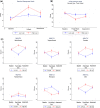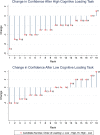The Preservation of Cued Recall in the Acute Mentally Fatigued State: A Randomised Crossover Study
- PMID: 26578315
- PMCID: PMC4695502
- DOI: 10.1007/s00268-015-3317-9
The Preservation of Cued Recall in the Acute Mentally Fatigued State: A Randomised Crossover Study
Abstract
Purpose: The objective of this study is to investigate the impact of acute mental fatigue on the recall of clinical information in the non-sleep-deprived state. Acute mental fatigue in the non-sleep-deprived subject is rarely studied in the medical workforce. Patient handover has been highlighted as an area of high risk especially in fatigued subjects. This study evaluates the deterioration in recall of clinical information over 2 h with cognitively demanding work in non-sleep-deprived subjects.
Method: A randomised crossover study involving twenty medical students assessed free (presentation) and cued (MCQ) recall of clinical case histories at 0 and 2 h under low and high cognitive load using the N-Back task. Acute mental fatigue was assessed through the Visual Analogue Scale, Stanford Scale and NASA-TLX Mental Workload Rating Scale.
Results: Free recall is significantly impaired by increased cognitive load (p < 0.05) with subjects demonstrating perceived mental fatigue during the high cognitive load assessment. There was no significant difference in the amount of information retrieved by cued recall under high and low cognitive load conditions (p = 1).
Discussion: This study demonstrates the loss of clinical information over a short time period involving a mentally fatiguing, high cognitive load task. Free recall for the handover of clinical information is unreliable. Memory cues maintain recall of clinical information. This study provides evidence towards the requirement for standardisation of a structured patient handover. The use of memory cues (involving recognition memory and cued recall methodology) would be beneficial in a handover checklist to aid recall of clinical information and supports evidence for their adoption into clinical practice.
Figures





Similar articles
-
Structured cues or modafinil for fatigue amelioration in clinicians? A double-blind, randomized controlled trial of critical clinical information recall in fatigued clinicians.Surgery. 2016 Apr;159(4):1181-90. doi: 10.1016/j.surg.2015.09.017. Epub 2015 Oct 29. Surgery. 2016. PMID: 26520004 Clinical Trial.
-
Cusp catastrophe models for cognitive workload and fatigue in a verbally cued pictorial memory task.Hum Factors. 2012 Oct;54(5):811-25. doi: 10.1177/0018720812442537. Hum Factors. 2012. PMID: 23156625
-
In a Concurrent Memory and Auditory Perception Task, the Pupil Dilation Response Is More Sensitive to Memory Load Than to Auditory Stimulus Characteristics.Ear Hear. 2019 Mar/Apr;40(2):272-286. doi: 10.1097/AUD.0000000000000612. Ear Hear. 2019. PMID: 29923867 Free PMC article.
-
Task difficulty differentially affects two measures of processing load: the pupil response during sentence processing and delayed cued recall of the sentences.J Speech Lang Hear Res. 2013 Aug;56(4):1156-65. doi: 10.1044/1092-4388(2012/12-0058). Epub 2013 Jun 19. J Speech Lang Hear Res. 2013. PMID: 23785182
-
Electrophysiological evidence for dissociable processes contributing to recollection.Acta Psychol (Amst). 1998 Apr;98(2-3):231-52. doi: 10.1016/s0001-6918(97)00044-9. Acta Psychol (Amst). 1998. PMID: 9621832 Review.
Cited by
-
A multicentre cross-sectional observational study of cancer multidisciplinary teams: Analysis of team decision making.Cancer Med. 2020 Oct;9(19):7083-7099. doi: 10.1002/cam4.3366. Epub 2020 Aug 13. Cancer Med. 2020. PMID: 32794351 Free PMC article.
-
Identification Performance During Quarantine by COVID-19 Pandemic: Influence of Emotional Variables and Sleep Quality.Front Psychol. 2021 Oct 15;12:691583. doi: 10.3389/fpsyg.2021.691583. eCollection 2021. Front Psychol. 2021. PMID: 34721142 Free PMC article.
-
Room for improvement in patient compliance during peripheral vascular interventions.JVS Vasc Insights. 2024;2:100059. doi: 10.1016/j.jvsvi.2024.100059. Epub 2024 Feb 8. JVS Vasc Insights. 2024. PMID: 38505294 Free PMC article.
-
An Integrated Literature Review of Time-on-Task Effects With a Pragmatic Framework for Understanding and Improving Decision-Making in Multidisciplinary Oncology Team Meetings.Front Psychol. 2019 Jul 9;10:1245. doi: 10.3389/fpsyg.2019.01245. eCollection 2019. Front Psychol. 2019. PMID: 31354555 Free PMC article. Review.
References
-
- World Health Organisation. Patient safety. Report for methods and measures working group of WHO patient safety. [World Health Organisation website] April, 2009. http://www.who.int/patientsafety/research/methods_measures/human_factors.... Accessed 31 July 2013
-
- Union E (2003) Directive 2003/88/EC of the European Parliament and of the Council of 4 November 2003. Off J Eur Union 9–19
-
- The Patient Saftey Advisory Group Health care worker fatigue and patient saftey. Jt Comm: Sentin Event Alert. 2011;48:1–4. - PubMed
-
- The Joint Commission. The Joint Commission: action urged to fight health care worker fatigue. pwrnewmedia.com 1–3 (2011). http://www.pwrnewmedia.com/2011/joint_commission/sea_fatigue/
Publication types
MeSH terms
LinkOut - more resources
Full Text Sources
Other Literature Sources
Medical

